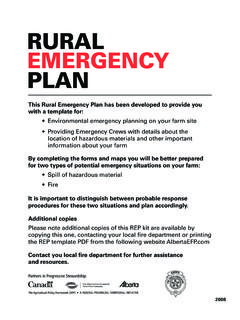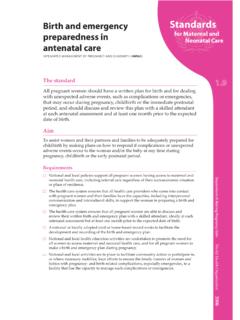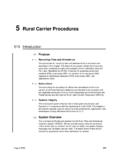Transcription of Emergency Medical Services Plan - Connecticut
1 Emergency Medical Services plan 2015 - 2020 Jewel Mullen, MD, MPH, MPA Commissioner Wendy H. Furniss, RNC, Branch Chief Judith A. Reynolds, EMT, EMS-I Coordinator State of Connecticut Department of Public Health 410 Capitol Avenue Box 340308 Hartford, CT 06134-0308 2 Table of Contents Page Mission Statement 3 Introduction 4 Authority 6 Model EMS Response System 7 EMS Administrative Structure 11 EMS Agenda for the Future The Vision 13 Priority Areas Goals and Objectives Regulation and Policy 14 Resource Management 16 Human Resources and Education 18 Transportation 20 Facilities 22 Communications 24 Public Information and Education 26 EMS for Children 27 Trauma Systems 28 Mass Casualty Care 30 Data and Evaluation 31 Medical Direction 33 Preparedness 35 Funding 37 Conclusion 38
2 3 Office of Emergency Medical Services Mission Statement The mission of the Office of Emergency Medical Services is to be responsible for program development activities, including, but not limited to: Public education and information programs Regional council oversight Training and Education Providing staff support to the EMS Advisory Board EMS for Children (EMS-C) Proactive administration, oversight and regulation of the statewide EMS and trauma system. 4 Introduction What Is EMS? Emergency Medical Services , more commonly known as EMS, is a system that provides Emergency Medical care. Once activated by an incident that causes serious illness or injury, the focus of EMS is Emergency Medical care of the patient(s), transportation to a hospital, documentation of patient condition and treatment and handoff to appropriate Medical personnel.
3 EMS is most easily recognized when Emergency providers, vehicles or helicopters are seen responding to incidents. But EMS is much more than a ride to the hospital, it also includes non- Emergency transportation, interfacility transport, and transport from a facility to home. It is a system of coordinated response and Emergency Medical care, involving multiple people and agencies. A comprehensive EMS system is ready every day for every kind of Emergency . The goal of EMS for each patient is stabilization, treatment and timely transport to a hospital that provides the required level of Medical care. EMS is an intricate system, and each component of this system has an essential role to perform as part of a coordinated system of Emergency Medical care.
4 An EMS system comprises all of the following components: Private and Public types of EMS agencies and organizations Communications and transportation networks Hospitals including but not limited to trauma centers and specialty care centers Highly trained professionals, including o Volunteer and career prehospital personnel o Physicians and nurses. o Administrators and government officials An informed public that knows what to do in a Medical Emergency 5 EMS cannot exist in isolation, but must be integrated with other Services and systems intended to maintain and enhance the community's health and safety. As seen in the previous graphic, EMS operates at the intersection of health care, public health and public safety.
5 A combination of the principles and resources of each is employed in the EMS system. Since EMS providers work in the community, they may be the first to identify public health problems and issues. Since EMS providers respond to all kinds of emergencies and all kinds of hazards, they often work with public safety colleagues in law enforcement and fire Services . But their primary mission is Emergency Medical care. The organizational structure of EMS, which includes who provides and finances the Services , varies significantly across the country and from community to community. Prehospital Services can be based in an independent governmental agency, fire department, hospital, non-profit corporation ( volunteer corps) or a commercial non-profit entity.
6 Regardless of who provides the Services , the essential components of an EMS system remain the same. Connecticut s EMS system includes all of these organizational structures. In order to be ready every day for every kind of Emergency an EMS system must be comprehensive. Developing and maintaining such a system requires thoughtful planning, preparation, and dedication from EMS stakeholders at the local, state and federals levels. For more information about EMS, please see is 6 Authority Connecticut General Statutes Sec. 19a-178(b). (Formerly Sec. 19-73z). Office of Emergency Medical Services . Statewide coordinated delivery plan . Model local Emergency Medical Services plans and performance agreements.
7 (a) There shall be established within the Department of Public Health an Office of Emergency Medical Services . The office shall be responsible for program development activities, including, but not limited to: (1) Public education and information programs; (2) administering the Emergency Medical Services equipment and local system development grant program; (3) planning; (4) regional council oversight; (5) training; and (6) providing staff support to the advisory board. (b) The Office of Emergency Medical Services shall adopt a five-year planning cycle for the statewide plan for the coordinated delivery of Medical Emergency Services required by subsection (a) of this section.
8 The plan shall contain: (1) Specific goals for the delivery of such Emergency Medical Services ; (2) a time frame for achievement of such goals; (3) cost data and alternative funding sources for the development of such goals; and (4) performance standards for the evaluation of such goals. 7 Model EMS System The Model EMS System consisting of the following elements has been developed by National Highway Traffic Safety Administration as a guide to understanding what constitutes a coordinated and comprehensive Emergency Medical response system. Each of the components should be addressed to achieve maximum effectiveness from the EMS system by strengthening the Chain of Survival.
9 The term Chain of Survival is a metaphor that refers to a series of actions taken to reduce the mortality associated with cardiac arrest. It can be applied to EMS actions no matter what the diagnosis. Prevention Prevention is a response to the reality that many Medical emergencies are indeed preventable. The two most prominent Medical emergencies in the Unites States are traumatic injury (falls, vehicular accidents, violence, etc.) and sudden cardiac death. Traumatic Injury is a preventable public health problem. It is a leading cause of death between the ages of 1 and 44 years old. (National Vital Statistics System, National Center for Health Statistics, CDC -2012) A reduction in mortality and morbidity can be accomplished through coordinated public information/education and prevention efforts that include: Providing programs and enacting laws designed to alter behavior or guide decision-making, such as drunken driving campaigns, seatbelt education, distracted driving and gun safety programs.
10 Providing conflict resolution education to help mitigate potentially volatile situations, for Emergency responders. Cardiovascular disease is the leading cause of death in the adult population. Providing programs that promote cholesterol and blood pressure management, smoking cessation, exercise, proper diet and weight control are part of comprehensive prevention. Citizen Recognition and Action Through public information and education programs, the general population must know several facts about the EMS System. They must know what the system is and must appreciate what the system is not. EMS is a system to deliver fast and effective Medical care in Emergency situations. It is not a replacement for primary care.

















